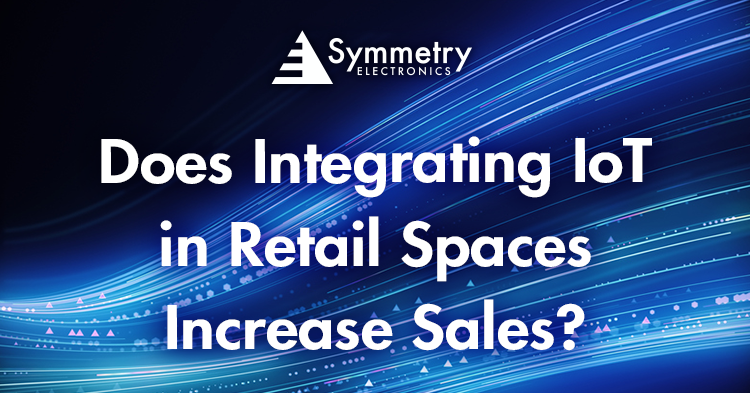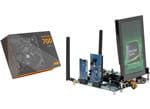- Home
- Symmetry Blog
- Does Integrating IoT in Retail Spaces Increase Sales?
Does Integrating IoT in Retail Spaces Increase Sales?
About Jari Haiston

In today's rapidly evolving retail landscape, businesses are constantly seeking innovative strategies to drive sales and deliver exceptional customer experiences. One technology that has emerged as a game-changer is the Internet of Things (IoT). By seamlessly connecting devices and gathering real-time data, IoT has revolutionized retail spaces, enabling businesses to make informed decisions, personalize interactions, and ultimately increase sales. IoT in retail spaces is transforming the market and driving revenue growth.
5 Ways IoT in Retail Spaces Increases Sales Potential
Markets and Markets values the global IoT in retail market at $14.5 billion. It’s projected to increase at a CAGR of 19.6% to reach $35.5 billion in the next five years. The steady adoption rate behind IoT in retail spaces can be attributed to increased sales potential with its integration. Integrating IoT in retail spaces increases sales potential in the following ways.
1. Enhanced Customer Experience
One of the significant ways IoT impacts sales in retail spaces is by enhancing the customer experience. IoT devices such as beacons, smart shelves, and connected displays enable retailers to gather data on customer behavior, preferences, and shopping patterns. This data empowers retailers to personalize interactions, deliver targeted promotions, and offer tailored recommendations to customers. By providing a seamless and personalized shopping experience, retailers can boost customer satisfaction, encourage repeat visits, and drive sales.
2. Optimized Inventory Management
IoT devices play a crucial role in optimizing inventory management, a key factor in driving sales. With IoT-enabled systems, retailers can monitor inventory levels in real-time, automate replenishment processes, and prevent stockouts or overstocks. Accurate and timely inventory information enables retailers to ensure that popular products are always available, reducing the risk of lost sales due to unavailability. Additionally, IoT helps businesses identify trends and optimize product assortment, leading to increased sales by aligning offerings with customer demand.
3. Dynamic Pricing and Promotions
IoT provides retailers with real-time insights into market demand, competitor pricing, and other relevant factors, enabling them to implement dynamic pricing strategies. By leveraging this data, retailers can adjust prices on the fly, optimize promotions, and deliver targeted discounts. Dynamic pricing helps businesses remain competitive, maximize profitability, and attract price-sensitive customers. IoT-powered analytics also facilitate targeted marketing campaigns, reaching the right audience with the right message, leading to increased sales conversion rates.
4. Streamlined Store Operations
IoT devices contribute to improved store operations, resulting in increased sales. Automated systems connected through IoT can optimize energy consumption, adjusting lighting and HVAC systems based on foot traffic or specific zones. This not only reduces operational costs but also creates a comfortable shopping environment, encouraging customers to stay longer and explore more products. Additionally, IoT-powered analytics can provide insights into store layout, product placement, and customer flow, allowing retailers to optimize store layouts for better visibility and increased sales.
5. Data-Driven Decision Making
IoT generates vast amounts of data that retailers can leverage to make informed decisions. By analyzing IoT-generated data, retailers can gain valuable insights into customer preferences, trends, and sales patterns. This data-driven approach helps businesses understand customer behavior, anticipate demand, and identify new sales opportunities. Retailers can optimize product offerings, marketing strategies, and customer engagement based on actionable insights derived from IoT data, resulting in increased sales and customer loyalty.
By leveraging IoT devices and data analytics, retailers can deliver personalized experiences, optimize inventory management, implement dynamic pricing strategies, streamline store operations, and make data-driven decisions. As the retail industry continues to evolve, embracing IoT technology becomes increasingly crucial for businesses seeking to stay competitive, increase sales, and create memorable shopping experiences for their customers. With IoT, the future of retail holds immense potential for growth and innovation.
Designing an IoT Device for Retail Applications
As a connected ecosystem of technology, several key technologies must come together to enable IoT in retail spaces. A cohesive connected system in a retail space will seamlessly integrate devices, data collection, analytics, intelligent decision-making, and more, but what do developers need to design an IoT device intended for retail applications and use cases?
- Sensors: Sensors form the foundation of IoT in retail spaces. These small devices can detect and measure various environmental parameters such as temperature, humidity, motion, light, and pressure. Sensors play a critical role in collecting real-time data from the physical retail environment.
- Connectivity: IoT relies on connectivity to transmit data between devices and back-end systems. Different connectivity options are used in retail spaces, including Wi-Fi, Bluetooth, Zigbee, RFID (Radio Frequency Identification), NFC (Near Field Communication), and cellular networks. These communication protocols facilitate seamless data exchange between devices, enabling real-time monitoring and control.
- Cloud Computing: Cloud computing is essential for IoT in retail spaces as it provides a scalable and centralized infrastructure for data storage, processing, and analysis. Cloud platforms enable retailers to securely store and manage the vast amounts of data generated by IoT devices. They also offer powerful computing capabilities for advanced analytics and machine learning algorithms to extract meaningful insights from the data.
- Data Analytics: IoT generates massive amounts of data, and leveraging this data is crucial for retail success. Data analytics tools and techniques, such as real-time analytics, predictive analytics, and machine learning algorithms, enable retailers to extract valuable insights from the collected data. These insights help retailers make data-driven decisions, optimize operations, and personalize the customer experience.
- Artificial Intelligence (AI): AI technologies, including machine learning and natural language processing, play a significant role in IoT in retail spaces. AI algorithms analyze data patterns, identify trends, and make intelligent predictions. For example, AI-powered recommendation systems can provide personalized product recommendations based on customer preferences and buying history.
- Edge Computing: Edge computing is a distributed computing paradigm where data processing and analysis occur at or near the edge devices, rather than relying solely on cloud-based servers. Edge computing brings processing closer to the source of data generation, reducing latency and enabling real-time decision-making. In retail spaces, edge computing allows for faster response times and localized data processing, enhancing the efficiency and effectiveness of IoT applications.
- Mobile Applications: Mobile applications act as interfaces for customers and store personnel to interact with IoT-enabled retail systems. Mobile apps can provide personalized experiences, enable mobile payments, deliver targeted promotions, and offer features like product scanning or self-checkout.
IoT in Retail Solutions Available at Symmetry Electronics
As a global distributor of next-generation IoT solutions, Symmetry Electronics is uniquely positioned to provide developers with the ideal components to create a state-of-the-art IoT device intended for retail spaces. Discover your next IoT in retail solution in the featured selections below.
MediaTek’s Genio 700
MediaTek's Genio chipset lineup signifies a significant advancement in semiconductor technology. These highly capable and flexible chipsets have been meticulously engineered to offer outstanding efficiency, performance, and connectivity across a diverse array of devices. With Genio 700 (MT8390) solutions, developers can count on a reliable and efficient platform that seamlessly integrates IoT development, resulting in exceptional user experiences.
The Genio 700 is a powerful platform that is ideal for smart home, interactive retail, industrial, and commercial implementations. Its ultra-responsive edge processing, advanced multimedia features, diverse sensor portfolio, versatile connectivity options, and compatibility with multitasking operating systems make the Genio 700 a comprehensive solution for a wide range of use cases.
Silicon Motion’s Ferri-eMMC®
The Ferri-eMMC® from Silicon Motion has been meticulously designed to cater to a diverse range of embedded applications while adhering entirely to the JEDEC standards for eMMC* 5.1 protocols. Its availability in 100/153-ball BGA packages simplifies PCB design and enables cost-effective manufacturing processes.
With the Ferri-eMMC® (SM662PEB BEST), you can expect top-notch performance and reliability as it incorporates industry-proven controllers and high-quality NAND components. This storage solution boasts advanced NAND management features, including error correction, bad block management, and health monitoring, making it the most dependable and non-volatile eMMC storage solution for cutting-edge industrial, embedded, and automotive applications. Specifically for automotive IVI (In-Vehicle Infotainment) applications, the Ferri-eMMC® boasts remarkable reliability, low defective parts per million (dppm), AEC-Q100 qualification, and long-term product support.
Migrating from HDD or raw NAND to Ferri-eMMC® opens up higher performance and capacity options for embedded applications. Moreover, Ferri-eMMC® can be customized through firmware to meet specific requirements and cater to various application needs.




